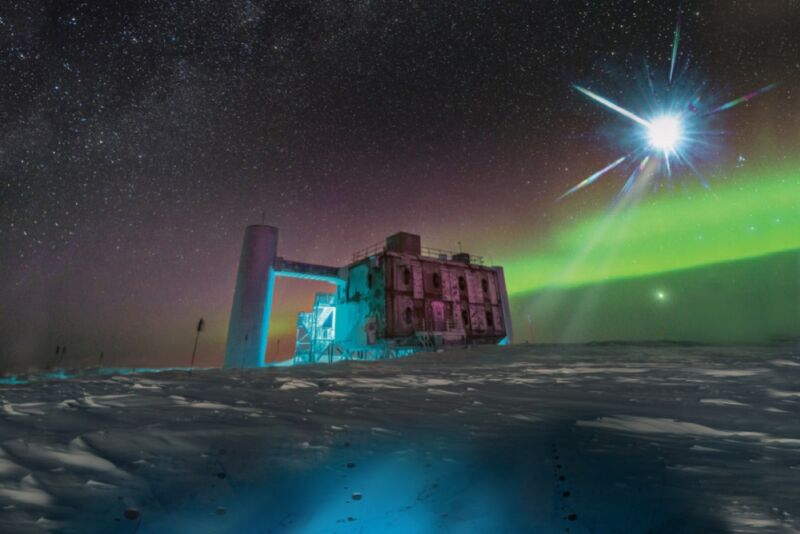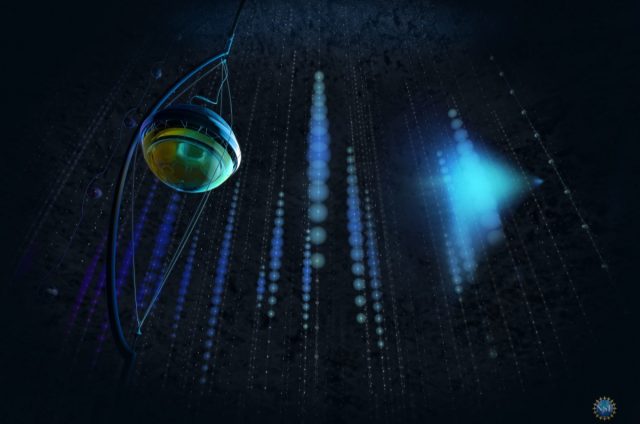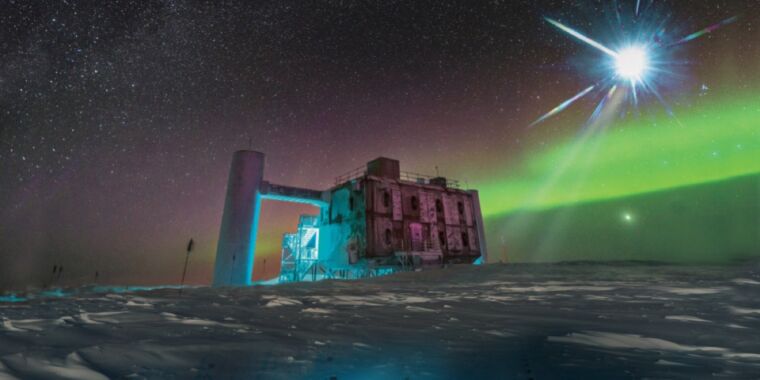
IceCube/NSF
Ever since French physicist Pierre Auger proposed in 1939 that cosmic rays must carry incredible amounts of energy, scientists have puzzled over what could be producing these powerful clusters of protons and neutrons raining down onto Earth’s atmosphere. One possible means for identifying such sources is to backtrack the paths that high-energy cosmic neutrinos traveled on their way to Earth, since they are created by cosmic rays colliding with matter or radiation, producing particles that then decay into neutrinos and gamma rays.
Scientists with the IceCube neutrino observatory at the South Pole have now analyzed a decade’s worth of such neutrino detections and discovered evidence that an active galaxy called Messier 77 (aka the Squid Galaxy) is a strong candidate for one such high-energy neutrino emitter, according to a new paper published in the journal Science. It brings astrophysicists one step closer to resolving the mystery of the origin of high-energy cosmic rays.
“This observation marks the dawn of being able to really do neutrino astronomy,” IceCube member Janet Conrad of MIT told APS Physics. “We’ve struggled for so long to see potential cosmic neutrino sources at very high significance and now we’ve seen one. We’ve broken a barrier.”
As we’ve previously reported, neutrinos travel near the speed of light. John Updike’s 1959 poem, “Cosmic Gall,” pays tribute to the two most defining features of neutrinos: they have no charge and, for decades, physicists believed they had no mass (they actually have a teeny bit of mass). Neutrinos are the most abundant subatomic particle in the universe, but they very rarely interact with any type of matter. We are constantly being bombarded every second by millions of these tiny particles, yet they pass right through us without our even noticing. That’s why Isaac Asimov dubbed them “ghost particles.”

Nicolle R. Fuller, IceCube/NSF
That low rate of interaction makes neutrinos extremely difficult to detect, but because they are so light, they can escape unimpeded (and thus largely unchanged) by collisions with other particles of matter. This means they can provide valuable clues to astronomers about distant systems, further augmented by what can be learned with telescopes across the electromagnetic spectrum, as well as gravitational waves. Together, these different sources of information have been dubbed “multimessenger” astronomy.
Most neutrino hunters bury their experiments deep underground, the better to cancel out noisy interference from other sources. In the case of IceCube, the collaboration features arrays of basketball-sized optical sensors buried deep within the Antarctic ice. On those rare occasions when a passing neutrino interacts with the nucleus of an atom in the ice, the collision produces charged particles that emit UV and blue photons. Those are picked up by the sensors.
So IceCube is well-positioned to help scientists advance their knowledge of the origin of high-energy cosmic rays. As Natalie Wolchover cogently explained at Quanta in 2021:
A cosmic ray is just an atomic nucleus—a proton or a cluster of protons and neutrons. Yet the rare ones known as “ultrahigh-energy” cosmic rays have as much energy as professionally served tennis balls. They’re millions of times more energetic than the protons that hurtle around the circular tunnel of the Large Hadron Collider in Europe at 99.9999991% of the speed of light. In fact, the most energetic cosmic ray ever detected, nicknamed the “Oh-My-God particle,” struck the sky in 1991 going something like 99.99999999999999999999951 percent of the speed of light, giving it roughly the energy of a bowling ball dropped from shoulder height onto a toe.
But where do such powerful cosmic rays originate? One strong possibility is active galactic nuclei (AGNs), found at the center of some galaxies. Their energy arises from supermassive black holes at the center of the galaxy, and/or from the black hole’s spin.








